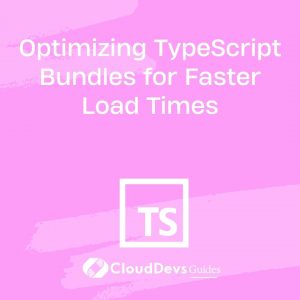Optimizing TypeScript Bundles for Faster Load Times
In today’s fast-paced digital world, user experience is paramount. Slow-loading web applications can lead to frustrated users and high bounce rates. One crucial aspect of web application optimization is reducing load times by optimizing your JavaScript bundles, especially when using TypeScript. In this article, we’ll delve into techniques and best practices to optimize TypeScript bundles for faster load times, ensuring a smoother experience for your users.
Table of Contents
1. Understanding the Importance of Bundle Optimization
Before we dive into optimization techniques, let’s understand why bundle optimization matters. When developing a web application, you write TypeScript code that gets transpiled to JavaScript. This JavaScript code is often bundled together into a single or multiple files. These bundles need to be loaded by the browser when users visit your application. Larger bundles mean more data that needs to be transferred over the internet, resulting in longer load times.
Optimizing your TypeScript bundles is all about reducing their size while maintaining functionality. Smaller bundles lead to faster downloads and quicker load times, ultimately enhancing user experience.
1.1. Tree Shaking
Tree shaking is a powerful technique for eliminating dead code from your bundles. Dead code refers to portions of your codebase that are not used, either due to conditional statements or unused imports. When you apply tree shaking, the build process identifies and removes these unused code segments from your bundles, resulting in smaller and more efficient bundles.
Example:
Consider the following TypeScript code:
typescript
import { unusedFunction, usedFunction } from './utilities';
if (condition) {
usedFunction();
} else {
unusedFunction(); // This function is never used
}
In this scenario, the unusedFunction is never called, making it a prime candidate for tree shaking.
1.2. Code Splitting
Code splitting involves breaking down your application’s codebase into smaller chunks, which can then be loaded asynchronously. This technique is especially useful for large applications, as it allows the browser to load only the necessary code for the current view, reducing the initial load time.
Example:
Using a popular library like React, you can leverage its built-in code splitting features:
typescript
import React, { lazy, Suspense } from 'react';
const LazyComponent = lazy(() => import('./LazyComponent'));
function App() {
return (
<div>
<Suspense fallback={<div>Loading...</div>}>
<LazyComponent />
</Suspense>
</div>
);
}
In this example, the LazyComponent is loaded only when it’s needed, improving the initial load time of your application.
1.3. Minification
Minification is the process of removing unnecessary characters from your code, such as whitespace, comments, and unused code. This helps to reduce the size of your bundles, leading to faster downloads. There are several tools available that can automatically minify your TypeScript code during the build process.
Example:
Before minification:
typescript
function calculateTotal(price: number, quantity: number) {
// Calculate total price
const total = price * quantity;
return total;
}
After minification:
typescript
function calculateTotal(a:number,b:number){return a*b}
1.4. Using Webpack for Bundle Optimization
Webpack is a popular module bundler that can greatly assist in optimizing your TypeScript bundles. It offers various plugins and configurations that help reduce bundle size and improve load times.
Example:
Consider the following webpack.config.js file with some optimization settings:
javascript
const path = require('path');
const TerserPlugin = require('terser-webpack-plugin');
const MiniCssExtractPlugin = require('mini-css-extract-plugin');
module.exports = {
entry: './src/index.ts',
output: {
filename: 'bundle.js',
path: path.resolve(__dirname, 'dist'),
},
optimization: {
minimize: true,
minimizer: [new TerserPlugin()],
},
module: {
rules: [
{
test: /\.tsx?$/,
use: 'ts-loader',
exclude: /node_modules/,
},
{
test: /\.css$/,
use: [MiniCssExtractPlugin.loader, 'css-loader'],
},
],
},
plugins: [
new MiniCssExtractPlugin({
filename: 'styles.css',
}),
],
};
In this configuration, the TerserPlugin is used to minify the JavaScript code, while the MiniCssExtractPlugin extracts and minifies CSS into a separate file.
1.5. Lazy Loading with React and TypeScript
Lazy loading is a technique commonly used in React applications to load components only when they are needed. This can significantly reduce the initial bundle size and load times.
Example:
Suppose you have a React application with multiple components. You can use TypeScript’s import() syntax along with React’s lazy and Suspense to achieve lazy loading:
typescript
import React, { lazy, Suspense } from 'react';
const LazyComponent = lazy(() => import('./LazyComponent'));
function App() {
return (
<div>
<Suspense fallback={<div>Loading...</div>}>
<LazyComponent />
</Suspense>
</div>
);
}
1.6. Advanced TypeScript Configuration
Fine-tuning your TypeScript configuration can also contribute to bundle optimization. By enabling certain compiler options, you can achieve better code optimization and smaller bundle sizes.
Example:
Consider the following tsconfig.json settings:
json
{
"compilerOptions": {
"target": "esnext",
"module": "esnext",
"strict": true,
"removeComments": true,
"declaration": true,
"sourceMap": false,
"outDir": "./dist",
"rootDir": "./src"
}
}
In this configuration, the removeComments option removes unnecessary comments from the output, while the declaration option generates type declaration files for your modules.
Conclusion
In a world where every millisecond counts, optimizing your TypeScript bundles for faster load times is essential for delivering an outstanding user experience. By applying techniques like tree shaking, code splitting, minification, and utilizing tools like Webpack, you can significantly reduce bundle sizes and enhance the performance of your web applications. Additionally, leveraging TypeScript’s advanced configuration options and embracing lazy loading with React can further contribute to smoother user interactions.
Remember, the key to successful optimization lies in finding the right balance between bundle size and functionality. Regularly audit and analyze your application’s performance to identify opportunities for improvement. By following the practices outlined in this article, you’ll be well on your way to creating lightning-fast web applications that keep your users engaged and satisfied.
Table of Contents









